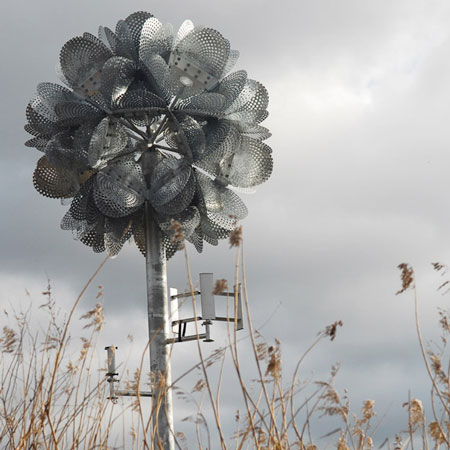London architects Tonkin Liu have completed a wind-powered metal flower beside the River Mersey in England.
Part of a regeneration project for the waterfront at Widnes, the 14 metre-high flower has petals of perforated galvanised steel.
At night the flower is illuminated LED lights powered by small wind turbines.
Here's some info from the architects:
WIDNES WATERFRONT FUTURE FLOWER IS UNVEILED
1 April 2010: Halton Borough Council has unveiled Tonkin Liuʼs Future Flower on the banks of the River Mersey in Widnes, Cheshire, UK.
The 14 metre high wind-powered metallic flower was commissioned as part of the wider Widnes Waterfront environmental uplift and public art programme, following an international competition held in 2007.
The project is funded by the North West Development Agency as part of a wider Waterfront Regeneration Programme to the clean up of the vacant, polluted riverfront land of Southern Widnes, Cheshire. The programme will transform over 200 acres of former industrial land on the banks of the River Mersey creating 1,100 jobs for the local economy with the development of a modern business park environment and associated leisure facilities.
The arrival of the flower signals the beginning of this transformation. It is intended to spur the repopulation of the waterfront by nature, and by people, drawing visitors from the neighbouring Catalyst Museum and Spike Island Visitor Centre eastward on to the trans Pennine Trail.
The site for the Future Flower, near the working chimneys of a power plant, past the swing bridge across the disused section of the St Helens Canal, expands in view with the open sky of the River Mersey, with a beautiful light that reflects off the water and the reeds. The inspiration for the Future Flower was drawn from this meeting of industry and nature.
The Future Flower is 4.5 metres in diameter and 14 metres above ground, marking a point at the grand scale of the River Merseyʼs horizon. Collaboration with sustainability engineers XCO2, structural engineers Eckersley OʼCallaghan, and art fabricators Mike Smith Studio have enabled the precision engineering of the Future Flower.
Constructed out of triangles and pentagons, the steel structural frame is in the form of an icosi-dodecahedron, onto which 120 perforate galvanised mild steel petals are fixed. Within the volume of the flower, a central stalk with branches holds 60 low voltage LED lights, directed to different clusters of petals. The lights are powered by three mini wind turbines attached to the stem, which operate off- grid.
At 5 miles per hour the wind will trigger the lights, activating incrementally as the wind increases. The lights create different intensities of red, depending on the wind speed, resulting in an ever-changing and dynamic flower. Without the wind, the perforate galvanised metal petals reflect the changing colours of the sky and the sun, as the wind picks up they become saturated with the red LED lights, and in the mist or rain they emit a halo of captured and reflected light.
As a universal symbol the flower embodies the optimism for the future of Widnes, while its performance embraces the future of renewable energy.
Halton Borough Council Leader Cllr Tony McDermott said: "It is an amazing piece of artwork. We are proud to see how quickly the Widnes Waterfront area is developing and expect thousands of people to enjoy the Future Flower over the coming months."
Key Facts:
Location: Widnes Warth, Widnes, Cheshire Size: 4.5 m diameter by 14 m tall Funding: North West Development Agency
Project credits:
Client: Widnes Waterfront EDZ Programme, Halton Borough Council Architects: Tonkin Liu Design Team: Mike Tonkin, Anna Liu, Neil Charlton, Suk Kyu Hong, Cristiano Billia
Structural Engineers: Eckersley OʼCallaghan Sustainability Engineers: XCO2 Energy
Electrical Engineers: Silent Power Systems
Fabricators: Mike Smith Studio Groundworks: Cheetham Hill Construction Limited
Widnes Waterfront
www.widneswaterfront.co.uk
Widnes Waterfront is one of only fourteen Economic Development Zones (EDZ) in the North West and will, over the coming years, coordinate the wholesale regeneration of a 200-acre former industrial area in Southern Widnes.
The Widnes Waterfront EDZ has been funded to date by European Regional Development Fund (ERDF), the Northwest Regional Development Agency (NWDA) and Halton Borough Council.
Tonkin Liu
www.tonkinliu.co.uk
Tonkin Liu is an award-winning London based architectural practice founded by Mike Tonkin and Anna Liu in 2001, making architecture unique to its location, the people who occupy it and the culture that surrounds it. Projects – which range from private houses to public spaces - sit at the interface of art and architecture.
The Future Flower extends the practice’s interest in natural geometry and structures that respond to the weather, an approach evident in the RIBA Award-winning Singing Ringing Tree, Burnley, Lancashire, which is a tree of stacked mild steel pipes which bends to the winds to produce a low, tuneful song.
Other public space projects to date include Promenade of Light, the £1 million RIBA London Award winning streetscape improvement of the area west of Old Street, central London, an exemplary urban regeneration scheme. The scheme resurrects the charming tree-lined promenade of the 18th and 19th century, an arrangement which invites dwelling and celebrates the experience of walking and interaction.
More Dezeen stories about Tonkin Liu:
Architectural jelly design competition winners (July 2008)

